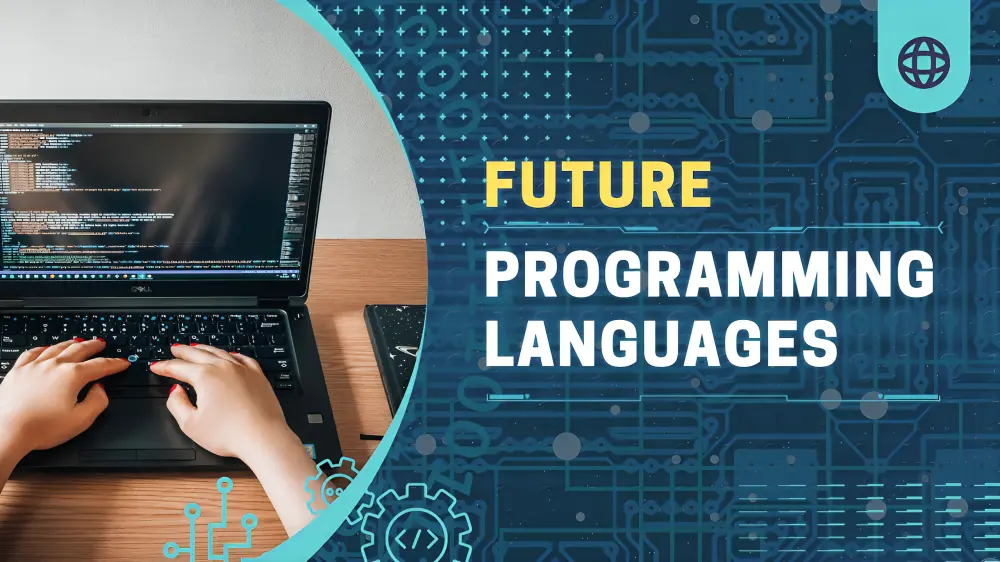Programming languages are the foundation of innovation in the rapidly changing field of technology. Every era has seen its own set of tools and techniques, from the early days of assembly code to the widespread use of languages like Python and JavaScript. However, the field of programming languages is expected to see substantial changes shortly. Let’s explore some possible paths for Future Programming Languages 2025.
Job Outlook Of Future Programming Languages 2025
| Language | Current Salary (USD) | Expected Salary 2030 (USD) |
| Julia | 115,000 | 130,000 |
| Kotlin | 110,000 | 125,000 |
| Rust | 120,000 | 140,000 |
| Swift | 115,000 | 130,000 |
| Typescript | 110,000 | 125,000 |
| ELM | 105,000 | 120,000 |
| Haskell | 110,000 | 125,000 |
| Scala | 110,000 | 125,000 |
| Zig | 110,000 | 125,000 |
| Vyper | 115,000 | 130,000 |
What Are Programming Languages?
A programming language is an organized collection of characters and guidelines used to create computer programs. Several of these languages incorporate graphical elements in addition to their textual foundation. Their primary purpose is to convey instructions that enable computers to carry out specific tasks, like creating intricate video games or basic web pages. There are many different programming languages available today, each with special qualities that make it easier to convert ideas from people into computer commands that can be executed.
Key aspects of programming languages include:
- Syntax and Semantics: Grammar, punctuation, and other structural rules of the language are all included in syntax, and semantics clarifies the meaning that these constructs are intended to convey.
- Abstraction: With the help of this feature, developers can express complex procedures in formats that are easier for humans to understand. It allows programmers to engage with intricate concepts without becoming overly bogged down in the specifics of computer architectures.
- Compiled Languages: These languages are converted into machine-readable binary code before being executed, which speeds up processing and enables direct hardware interaction. Examples include Rust, C, and C++.
- Interpreted Languages: On the other hand, interpreted languages are translated in real-time using an interpreter while they are being executed, providing a higher degree of flexibility, albeit possibly at the expense of speed. Some notable examples are Ruby, JavaScript, and Python.
Future Programming Languages 2025
- Kotlin: Because of its versatility and conciseness, Kotlin, a statically typed language, is expected to become more and more popular for creating Android applications. Its future might include more improvements made to the Android app development process in addition to wider use in server-side and web development.
- Benefits
- Conciseness: Because Kotlin eliminates boilerplate code, codebases become cleaner and easier to maintain.
- Interoperability: Developers will find the transition easier because of its smooth integration with Java.
- Safety: Code reliability is increased by Kotlin’s type system, which helps to prevent null pointer exceptions.
- Rust: Because of its memory safety and performance, Rust is a popular language for systems programming. Rust is probably going to keep pushing the boundaries of system-level development in the future, encompassing critical software infrastructure and Internet of Things devices.
- Benefits
- Memory Safety: Rust’s ownership mechanism guards against common memory-related errors.
- Performance: It provides minimal control without compromising security.
- Concurrency: The ownership model of Rust makes safe concurrent programming possible.
- Julia: Julia is a dynamic, high-performance programming language that is well-known for its speed in scientific and numerical computing. It is expected that Julia will keep developing, and becoming increasingly capable of managing machine learning and data analytics jobs. Its future is in growing its ecosystem of libraries and packages to become the language of choice for researchers and data scientists.
- Benefits
- Speed: Julia is perfect for computationally demanding tasks because of its just-in-time (JIT) compilation, which guarantees quick execution.
- Interoperability: Its usability is increased by its smooth interface with other languages, such as Python and C.
- Parallelism: Complex computations are made simpler by Julia’s built-in support for parallel computing.
- TypeScript: TypeScript is a JavaScript subdivision that enhances the language with static typing. Its future is in influencing web development even more and encouraging the development of reliable and scalable web applications.
- Benefits
- Static Typing: TypeScript reduces bugs in production by detecting type-related errors during development.
- Tooling: It offers first-rate tooling support, such as code navigation and auto-completion.
- Compatibility: JavaScript projects already in existence can gradually transition to TypeScript.
- Haskell: Purely functional languages like Haskell are renowned for having robust type systems. Its future could involve broader use in high-assurance systems, finance, and academia due to its mathematical foundations supporting rigorous software development.
- Benefits
- Safety: The type system in Haskell guarantees code accuracy and guards against numerous common mistakes.
- Concurrency: It is very good at handling parallel and concurrent programming.
- Expressiveness: Haskell’s graceful syntax encourages clear, concise code.
- Scala: The flexible language Scala combines object-oriented and functional programming. In the future, it might be used more in the fields of machine learning and data science as well as in the construction of scalable backend systems.
- Benefits
- Scalability: Scala is a good choice for developing high-performance systems because of its functional constructs and Akka framework.
- Expressive: With its extensive feature set, it encourages the writing of expressive code.
- Interoperability: Because of Scala’s smooth Java interface, a wide ecosystem is accessible.
- Zig: Zig is a systems programming language designed with performance and safety in mind. It might find use in low-level system development in the future, particularly in game engines and embedded systems.
- Benefits
- Safety: Zig guards against common C/C++ vulnerabilities with its stringent memory safety features.
- Performance: Fine-tuned control over minute details is provided, with speed optimization.
- Simplicity: Zig places a high value on usability and simplicity in systems programming.
- Vyper: Vyper is an Ethereum smart contract development language inspired by Python. Its future is in decentralized applications and the blockchain space, where it will enhance smart contract readability and security.
- Benefits
- Security: Vyper reduces the number of possible attack points by making the language simpler.
- Readability: The Pythonic syntax of smart contracts makes them easier to comprehend.
- Ethereum Compatibility: Because Vyper was created especially for Ethereum’s EVM, integration is guaranteed to be smooth.
- Swift: Apple’s programming language for creating apps, Swift, is becoming more and more popular across watchOS, tvOS, iOS, and macOS. Its future will entail further cross-platform use capability expansion and refinement for the development of the Apple ecosystem.
- Benefits
- Speed: Swift ensures quick app performance because it is highly optimized for Apple devices.
- Safety: It lowers the chance of crashes with improved memory safety features.
- Readability: Swift’s simple syntax encourages the readability and maintainability of code.
- ELM: The functional programming language ELM was created specifically for front-end web development. Elm might gain popularity in the future since it provides a more dependable and manageable web interface development solution than JavaScript.
- Benefits
- No Runtime Errors: Null pointer exceptions and other runtime errors are eliminated by Elm’s strong type system.
- Predictability: It makes code more logical to reason about by enforcing a unidirectional data flow.
- Community: Elm’s community promotes best practices by placing a strong emphasis on dependability and maintainability.
FAQ of Future Programming Languages
Q1. Will Python be replaced by AI?
A. While AI is a useful tool for Python developers, it shouldn’t be used in place of us. To guarantee the accurate development and delivery of a digital product, human Python developers are necessary.
Q2. What is the future—Python or Java?
A. Trends and the most recent data suggest that Python will be slightly superior to Java in 2024. These are the causes: Popularity and Development: In the TIOBE Index for May 2023, Java comes in third place, and Python comes in second. This suggests that among developers right now, Python is more widely used.
Q3. Can AI write computer code?
A. As time goes on, artificial intelligence is proving to be almost as proficient as humans in a growing number of coding tasks. It makes sense since the process of writing code is more technical than that of writing poetry, which is more intuitive.





